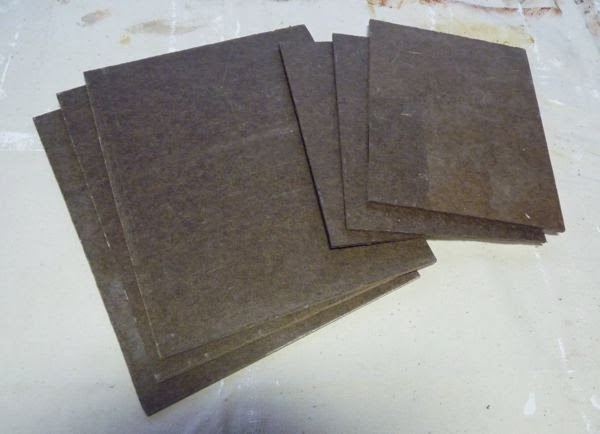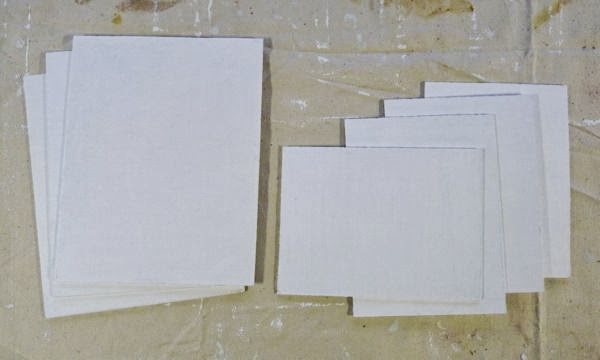For the small artwork I create, painting panels are ideal. They are light, sturdy and rigid, can be prepared with multiple surfaces, and are easy to frame. The boards can be gessoed, or have primed cotton or linen canvas adhered. These can be purchased, ready-to-use; or can be custom made by the artist.

Unprimed panels
I like to prepare my own. This gives me just what I want, and saves money too. My preferred painting support is a rigid panel that is primed and toned with a color. My most favorite is a panel with primed Belgian linen. But, they can be expensive; even when I make them myself.
Selecting and Cutting a Board
There are many suitable materials for a support, like hardwood, ragboard, gatorboard, etc. Doorskin veneer is also nice to use. I tend to use 1/8″ thick untempered hardboard. It can be purchased at home improvement stores cheaply; and then cut down to the sizes needed.
I make sure the panels are cut squarely, then lightly sand with a fine grit paper or sanding sponge, being sure to do the edges. Afterward, the panel is cleaned with a lint free cloth to insure no dust remains.
Priming with Acrylic Gesso
I lay out a canvas cloth to keep the working space clean, paper towels to remove excess gesso, a bucket of clean water to rinse my brush, a palette knife for mixing, a 1 1/2 inch soft bristle brush, and of course acrylic gesso. Next, I set down the boards to be primed; all the same size or a variety, depending on what I need. Then I mix some gesso with a little water in a shallow plastic tray. It should not be watery, but just thin enough to go on without noticeable ridges.

Workspace and materials
First Coat: I begin by painting the edges, then lay the panel flat and brush randomly until the surface is covered evenly. Working quickly, on one board at a time, so the paint doesn’t begin drying. Then, I smooth out the gesso by laying the brush over and lightly stroking horizontally while overlapping slightly.
I inspect the surface, looking at an angle, to check for brush hairs or specks. Remove any and re-stroke so the gesso lays uniformly across the whole panel. When satisfied, I move on to the next panel until all are done with the first thin coat.
The panels are then left to dry for at least two hours. Sometimes the wet gesso on the edge will stick to the work cloth. So, I move them slightly to keep that from happening.
Second Coat: First, I look to be sure there are no apparent specks or bumps on the surface. If I see something, it is carefully picked off or lightly sanded back. On the second and subsequent coats, I use the gesso straight from the jar; without thinning it. This will begin to give a slight texture to the surface. After applying the gesso, I stroke it in a vertical direction; 90 degrees to the first coat. Again, checking for any stray brush hairs. Then, I let this layer dry for at least two hours.

Completed panels with gesso
Next, the back side of the panel is done in the same way. It is important to seal the board on all sides to protect it from moisture. And, it also gives it a more professional look. Another reason is that, when the gesso dries, it creates a slight tension on that side of the panel. With a large board, this could cause the panel to warp. So, applying another coat on the reverse side evens out the tension.
Third Coat: This layer is done the same as the second coat. Except that, when it is applied, it is lightly stroked in a horizontal direction. Again, 90 degrees to the last coat. Usually, three coats is sufficient for a nice surface. But, additional layers can be done to get it just right.
If I have done it correctly, then the surface of the gessoed panel will resemble a fine linen texture. At times, I will use layers of random strokes to create a rougher surface. The paint layer will adhere nicely to this gesso prepared ground.
Using Quality Materials
It is important to use good quality artist materials. I have just recently switched to acrylics, and I’ll be trying different brands. Golden has a good selection of hues and mediums, so I’m using those for now.
Keep in mind that acrylic gesso is formulated differently than acrylic paints. It is made to provide a surface that will bond with the paint layer. Do not use regular paint for the ground, because subsequent paint layers will not adhere properly.
Making my own painting panels is pretty easy, and I can control the quality and texture. Plus, it can be way less expensive.
In another post, I talk about adding a Toned Ground to the painting panel.



[…] another post, I talk about Priming Panels with acrylic […]